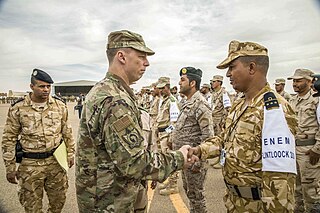
The Richat Structure, or Guelb er Richât, is a prominent circular geological feature in the Adrar Plateau of the Sahara. It is located near Ouadane in the Adrar Region of Mauritania. In Hassaniya Arabic, rīšāt means feathers and it is also known locally in Arabic as tagense, referring to the circular opening of the leather pouch that is used to draw water from local wells.

Adrar is a large administrative region in Mauritania, named for the Adrar Plateau. The capital is Atar. Other major towns include Choum, Chinguetti and Ouadane. The region borders Western Sahara and the Mauritanian region of Tiris Zemmour to the north, Mali and the Mauritanian region of Hodh Ech Chargui to the east, the Mauritanian regions of Trarza and Tagant to the south and the Mauritanian region of Inchiri to the west.

Oualata or Walata is a small oasis town in southeast Mauritania, located at the eastern end of the Aoukar basin. Oualata was important as a caravan city in the thirteenth and fourteenth centuries as the southern terminus of a trans-Saharan trade route and now it is a World Heritage Site.

Tidjikja is the capital of the Tagant region of central Mauritania, lying on the Tagant plateau. Founded in 1680, it has a population of around 11,000 people.

Ouadane or Wādān is a small town in the desert region of central Mauritania, situated on the southern edge of the Adrar Plateau, 93 km northeast of Chinguetti. The town was a staging post in the trans-Saharan trade and for caravans transporting slabs of salt from the mines at Idjil.

Chinguetti is a ksar and a medieval trading center in northern Mauritania, located on the Adrar Plateau east of Atar. Chinguetti had a population of 4,800 as of 2013.

Atar is a town in northwestern Mauritania, the capital of the Adrar Region and the main settlement on the Adrar Plateau. Situated on the oued Seguellil, it is home to an airport, a museum and a historic mosque, constructed in 1674.

The Adrar is a highland natural and historical region of the Sahara Desert in northern Mauritania. The Adrar Region, an administrative division of Mauritania, is named after the traditional region. It is sometimes called Adrar Tamar to distinguish it from other areas called Adrar in the Sahara.

The Chinguetti Mosque, also known as the Chinguetti Great Mosque, is a Sunni Islam mosque in Chinguetti, Adrar Region, Mauritania. It was an ancient center of worship created by the founders of the oasis city of Chinguetti in the Adrar region of Mauritania in the thirteenth or fourteenth century. The minaret of this ancient structure is claimed to be the second oldest in continuous use anywhere in the Muslim world.

A historic site or heritage site is an official location where pieces of political, military, cultural, or social history have been preserved due to their cultural heritage value. Historic sites are usually protected by law, and many have been recognized with official historic status. A historic site may be any building, landscape, site or structure that is of local, regional, national, or global significance. Usually this also means the site must be at least 50 years or older.

Ksar el Barka is a ruined town in Mauritania. In 2013 it had a population of 7,037.

Mauritania, formally the Islamic Republic of Mauritania, is a sovereign country in Northwest Africa. It is bordered by the Atlantic Ocean to the west, Western Sahara to the north and northwest, Algeria to the northeast, Mali to the east and southeast, and Senegal to the southwest. By land area Mauritania is the 11th-largest country in Africa and 28th-largest in the world; 90% of its territory is in the Sahara. Most of its population of some 4.3 million lives in the temperate south of the country, with roughly a third concentrated in the capital and largest city, Nouakchott, on the Atlantic coast.

The ancient ksour of Ouadane, Chinguetti, Tichitt and Oualata in Mauritania were inscribed on the UNESCO World Heritage List in 1996.

The National Museum of Mauritania, also known as the National Museum of Nouakchott, is a national museum in Nouakchott, Mauritania. It is located to the southwest of the Hotel Mercure Marhaba, west of Hotel de Ville, northwest of Parc Deydouh, and northeast of the Mosque Ould Abas.
The 2018 Coupe du Président de la République is the 41st edition of the Coupe du Président de la République, the knockout football competition of Mauritania.

Ouadane is a department of the Adrar Region in Mauritania. This mostly desert-area department is made up of the single Ouadane town.

The following lists events in the year 2020 in Mauritania.


















